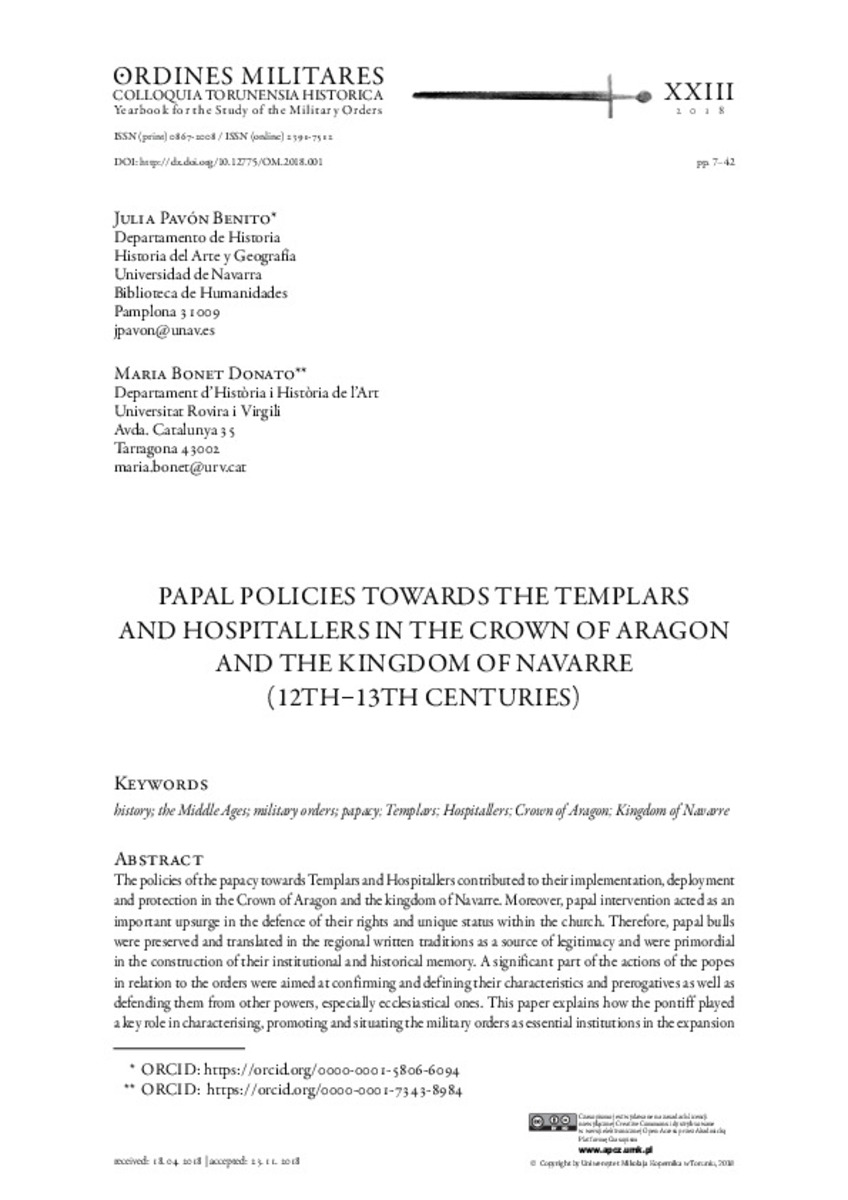Full metadata record
| DC Field | Value | Language |
|---|---|---|
| dc.creator | Pavón-Benito, J. (Julia) | - |
| dc.creator | Bonet, M. (María) | - |
| dc.date.accessioned | 2023-02-21T12:34:06Z | - |
| dc.date.available | 2023-02-21T12:34:06Z | - |
| dc.date.issued | 2018 | - |
| dc.identifier.citation | Pavón-Benito, J. (Julia); Bonet, M. (María). "Papal policies towards the Templars and Hospitallers in the Crown of Aragon and the Kingdom of Navarre (12th-13th centuries)". Ordines militares. 23, 2018, 7 - 42 | es |
| dc.identifier.issn | 0867-2008 | - |
| dc.identifier.uri | https://hdl.handle.net/10171/65521 | - |
| dc.description.abstract | The policies of the papacy towards Templars and Hospitallers contributed to their implementation, deployment and protection in the Crown of Aragon and the kingdom of Navarre. Moreover, papal intervention acted as an important upsurge in the defence of their rights and unique status within the church. Therefore, papal bulls were preserved and translated in the regional written traditions as a source of legitimacy and were primordial in the construction of their institutional and historical memory. A significant part of the actions of the popes in relation to the orders were aimed at confirming and defining their characteristics and prerogatives as well as defending them from other powers, especially ecclesiastical ones. This paper explains how the pontiff played a key role in characterising, promoting and situating the military orders as essential institutions in the expansion of the church in the Crown of Aragon and Navarre and, specifically, of the reformist papacy. Despite this favouritism, there were differences between the orders and other ecclesial authorities such as the diocesans. The study focuses on the papal bulls addressed to the North East Hispanic priories, and offers an analysis of the diplomas, addressing the type of issues and circumstances that led to the direct intervention by the pope in Templar and Hospitaller affairs. It also explains what this connection meant and how it was projected by both role-players in ecclesiastic and political arenas, as well as the consequences in the construction of the new ecclesiology. | es_ES |
| dc.language.iso | eng | es_ES |
| dc.publisher | Nicolaus Copernicus University in Toruń | es_ES |
| dc.rights | info:eu-repo/semantics/openAccess | es_ES |
| dc.subject | History | es_ES |
| dc.subject | The middle ages | es_ES |
| dc.subject | Military orders | es_ES |
| dc.subject | Papacy | es_ES |
| dc.subject | Templars | es_ES |
| dc.subject | Hospitallers | es_ES |
| dc.subject | Crown of Aragon | es_ES |
| dc.subject | Kingdom of Navarre | es_ES |
| dc.title | Papal policies towards the Templars and Hospitallers in the Crown of Aragon and the Kingdom of Navarre (12th-13th centuries) | es_ES |
| dc.type | info:eu-repo/semantics/article | es_ES |
| dc.description.note | CC BY ND 4.0. The Creator/Contributor is the Licensor, who grants the Licensee a non-exclusive license to use the Work on the fields indicated in the License Agreement. | es_ES |
| dc.identifier.doi | 10.12775/OM.2018.001 | - |
| dadun.citation.endingPage | 42 | es_ES |
| dadun.citation.publicationName | Ordines militares | es_ES |
| dadun.citation.startingPage | 7 | es_ES |
| dadun.citation.volume | 23 | es_ES |
Files in This Item:
Statistics and impact
Items in Dadun are protected by copyright, with all rights reserved, unless otherwise indicated.






